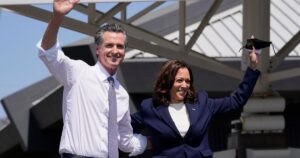Hope springs eternal in the world of great-power diplomacy. Even today, in the throes of a norm-busting trade war with China, there is talk of some kind of leader-to-leader grand bargain between U.S. President Donald Trump and his Chinese counterpart, Xi Jinping. Trump says he “would love to get a deal with China.” Xi, who has responded to Trump’s tariff broadside in a measured and targeted way, has left the door open for a negotiated settlement. Such a breakthrough in U.S.-Chinese relations might sound alluring at this particularly fraught moment, but the history of the strategic rivalry between China and the United States and each country’s internal politics make the likelihood of reaching one remote.
Since 1950, China and the United States have pivoted from cooperation to confrontation and back again, several times. They have done so for geopolitical and domestic political reasons. As a rule, they have been able to cooperate on security only when facing a clear and present danger from a common enemy. U.S. President Richard Nixon’s historic visit to China in 1972, for example, led to a series of agreements aimed at containing the Soviet Union. And the two countries have managed economic cooperation only when both were governed by domestic coalitions that supported the expansion of international trade, as during the 1990s and early 2000s. Cooperation across both security and economic affairs, meanwhile, has always been elusive.
Today, there is nothing—internationally or domestically—that would suggest this is a propitious moment for China and the United States to transcend their differences in either the security or economic realm. Both countries are currently governed by strident nationalist coalitions, with an antiglobalization backlash dominating domestic politics. There is also no common security threat drawing the two countries together. Indeed, they are more likely to find themselves on opposite sides (or at least at orthogonal purposes) regarding international conflicts, such as those between Russia and Ukraine and between Israel and Iran. Only once in the past hundred years, at the height of the Cold War in the 1950s and 1960s, did China and the United States find themselves completely at loggerheads on both dimensions of statecraft. With today’s environment becoming more like that one, it is hard to imagine either leader meaningfully resetting relations or addressing any of the major issues dividing them.
Trump won’t want to play the cards in his hand. If he were to push for a grand bargain, it would almost certainly be a Faustian one for the United States. For Washington to seal any sweeping, across-the-board deal, the United States would likely have to make concessions on Taiwan or on Beijing’s claims in the South China Sea—thus potentially unraveling a security architecture that has underpinned regional stability for decades.
The strategic costs to the United States of conceding influence in the region to China far outweigh any potential economic benefits—including increased access to the Chinese market or even resurgent American manufacturing. Given the circumstances, American policymakers should focus on more manageable, critical goals, such as reducing the risk of inadvertent war, particularly in the South China Sea and other flash points. A small but real step back from the brink would be grand indeed.
USEFUL ADVERSARIES, USEFUL PARTNERS
History shows that relations between China and the United States sour when the countries do not share a common enemy and when inward-looking, nationalist economic interests are in ascendance in domestic politics. Following the Communist Party’s victory in the Chinese Civil War in 1949, for instance, Americans from Wall Street to Main Street viewed the People’s Republic of China as a key part of the widening global communist threat orchestrated from Moscow. This view crystallized during the Korean War, when the two countries faced off on the battlefield, and it hardened in the 1960s, when the U.S.-Chinese strategic rivalry spread across the developing world as part of the Cold War competition for “hearts and minds.”
Domestic political imperatives buttressed those geopolitical considerations and fueled hostility on both sides. In the 1950s and 1960s, globalization and trade liberalization were off the table in both countries, albeit for different reasons. The United States favored managed, not liberalized, trade, focusing almost exclusively on commercial ties with its Western allies. Meanwhile, Washington did everything it could to isolate and punish China economically by imposing a broad trade embargo. In Mao Zedong’s China, this hardly mattered. During these years, China had little interest in trading with the outside world. Apart from the Soviet Union, North Korea, and a few other outposts such as Albania, China kept foreign economic ties to a minimum.
For the first two decades of the Cold War, China and the United States were not only bitter strategic rivals; they also served, as political scientist Tom Christensen has noted, as “useful adversaries” for each other domestically. Political leaders in both countries found advantage by pointing to an implacable foe at critical moments of domestic vulnerability. For Mao, this was to shore up power following the calamitous Great Leap Forward and amid the tumult of the Cultural Revolution. And for U.S. presidents from Dwight Eisenhower to Lyndon Johnson, pointing to a hostile China helped sell a foreign policy of deepening engagement in South Vietnam to a public that would not buy it on its own merits. This tactic, however, came at the price of strengthening hard-liners in both countries, which in turn deepened the rift between Beijing and Washington.
By the 1970s, Beijing viewed Moscow as an even greater threat than Washington. The two communist giants had border clashes in 1969, and Beijing’s anxiety about facing off against both of the world’s superpowers was palpable. Simultaneously, the United States was seeking to extricate itself from a deeply unpopular war in Southeast Asia and recalibrate its Cold War strategy in Asia and beyond. China and the Soviet Union were no longer universally seen in Washington as part of a monolithic communist bloc, and this convergence of strategic interests led to a thaw in U.S.-Chinese relations, beginning with Nixon’s visit to China, which was facilitated by the secret diplomacy of his national security adviser, Henry Kissinger.
U.S.-Chinese cooperation across both security and economic affairs has always been elusive.
The visit marked the beginning of a “tacit alliance,” as Kissinger put it at the time, to counterbalance Soviet power. Although formal diplomatic relations were not established until 1979, the 1970s set the stage for a series of strategic initiatives from “Ping-Pong diplomacy” and other charm offensives to increasing trade and technical exchanges to the beginnings of actual defense cooperation that lasted throughout the 1980s. Although strategic cooperation flourished, economic cooperation between China and the United States remained limited during the 1970s. China’s economy was still largely autarchic and disconnected from global markets. All industry remained state-owned, and agriculture was still collectivized. Mao’s successor, Hua Guofeng, even doubled down on whatever his predecessor had been doing, replacing five-year central plans with a ten-year one.
It wasn’t until the 1980s, when domestic coalitions favoring globalization took firmer root in both countries, that security and economic interests on both sides were briefly in sync. In China, the new paramount leader, Deng Xiaoping, along with his deputies Hu Yaobang and Zhao Ziyang, pursued structural economic reforms, committing China to the twin goals of market reform and integration into the global economy. And in the United States, President Ronald Reagan championed globalization, promoting trade liberalization and open markets. Strategically, meanwhile, China and the United States continued to cooperate against the Soviet Union. The 1980s saw collaboration in arming Afghan resistance fighters (the mujahideen) during the Soviet invasion of Afghanistan, which further strengthened the U.S.-Chinese security relationship. The emergence of pro-globalization coalitions in both countries, combined with a common enemy, created a conducive environment for economic as well as strategic cooperation that would last until the end of the Cold War.
The collapse of the Soviet Union in 1991 fundamentally altered the calculus. With the common enemy gone, the strategic rationale for security cooperation all but disappeared even as economic cooperation flourished. In Washington, Beijing’s growing economic and military power raised questions about the credibility of the United States’ forward presence in Asia, as did China’s willingness to push back against perceived encroachments on its interests in the region. The 1995–96 crisis in the Taiwan Strait, when Beijing fired a series of missiles near Taiwan as a warning against movements toward independence, highlighted the issues and raised the stakes. In the face of Chinese assertiveness, the United States demonstrated its military commitment to Taiwan by deploying multiple aircraft carriers to the region.
With only economic interests in alignment, relations between Beijing and Washington were plagued by mixed motives, as leaders navigated conflicting pressures to cooperate and compete. U.S. President Bill Clinton, for instance, devised a rationale for doubling down on economic interests that he thought could one day lead to strategic alignment: using free trade and investment as a means to integrate China into the U.S.-led global order. With Deng’s successor Jiang Zemin deepening reformist policies, China seemed willing to play ball. The net result was spectacular growth in U.S.-Chinese trade and the start of negotiations that led to China’s accession to the World Trade Organization (WTO) in 2001. The U.S. and Chinese economies have been deeply intertwined ever since.
OUT OF ALIGNMENT
Last year, China and the United States traded over $580 billion in goods and services. China is the United States’ third-largest trade partner. The United States, meanwhile, is China’s largest single export market, not counting regional blocs such as the Association of Southeast Asian Nations or the EU. Beijing holds over $1 trillion in U.S. treasury securities. But this mutual economic dependence masks deeper centrifugal forces that have been gradually pulling the two countries apart. Domestically, both American and Chinese leaders are facing increasing political pressure to turn inward and away from global markets—and for roughly the same reason: the inequality and dislocation globalization is believed to have caused.
In the United States, economic dislocation precipitated and accelerated by globalization has led to a growing backlash against free trade and international institutions. Signs of trouble were evident as early as the 1990s in the battle over Clinton’s North American Free Trade Agreement and the Seattle protests over the WTO. But it was not until the 2008 global financial crash and the Obama administration that domestic concerns about job losses and China’s trade practices became hot-button electoral issues. Lawmakers on Capitol Hill increasingly linked the United States’ economic troubles to China’s emergence as an economic powerhouse. It was a short step from there to the anti-Chinese, “America first” neomercantilist agenda that Trump championed on the campaign trail and then from the Oval Office.
Parallel developments were afoot in China—first under the leadership of Hu Jintao in the first decade of this century and then more dramatically under Xi in the 2010s—as the country pivoted toward a more assertive nationalism and an inwardly focused policy agenda. Xi emphasized “common prosperity” and social equity, the green transition, and eventually, the “China Dream,” which promised rising living standards but also a better overall quality of life, a powerful and confident China, and a more consumer-oriented economy focused on leading-edge technologies. These moves entailed reducing its reliance on foreign technology and investment and increasing domestic demand, fostering domestic innovation, and favoring the state over the market. In the 2010s, amid its fears that the United States was winning the hearts and minds of young Chinese, Beijing increasingly blamed Washington for its economic and social problems.
U.S. policymakers should focus on manageable, critical goals, such as reducing the risk of war.
With each side scapegoating the other and no common enemy to create incentives to cooperate, the political space for alignment over strategic-military matters narrowed. Attempts to find common ground over nontraditional security challenges such as terrorism, climate change, and global health foundered during the George W. Bush and Obama administrations. For Washington, fighting a so-called global war on terror was paramount in the first decade of the century, while Beijing was much more focused on developments in East Asia. U.S.-Chinese efforts to cooperate over climate change became entangled in broader disputes over trade, technology, subsidies, and intellectual property.
By 2020, the COVID-19 pandemic exposed and exacerbated confrontational tendencies. In the United States, political leaders lambasted China for its handling of the outbreak, with Trump pejoratively labeling the disease the “China virus.” China rejected these accusations and portrayed its pandemic response as superior, later using “vaccine diplomacy” to compete with the United States and bolster its global image. The pandemic also intensified economic nationalism: both countries moved to secure critical supply chains domestically and then, during Joe Biden’s presidency, to restrict access to key materials and leading-edge technologies.
As strategic mistrust deepened during the Biden years, Washington and Beijing came to view the other’s actions through a lens of great-power rivalry. Both countries increasingly sought to weaponize aspects of their interdependence (imposing export controls on microchips and rare earths, for instance) and rachet up threats over publicly held debt, state or state-directed investment flows, and more. Economic statecraft could not become the same kind of battleground it was in the 1950s and 1960s, when China and the United States operated in separate trading spheres. Their dependence on each other necessitated a subtler dance, but it also opened additional avenues of competition and angles of leverage that were unthinkable during the Cold War. Although both sides recognize the need to prevent rivalry from spiraling into open conflict, the relationship remains volatile and unstable.
LESS IS MORE
Six months into the new Trump administration, relations have only become more precarious. Trump’s over-the-top tariffs on China in April, jacked up to an eye-popping 145 percent, were intended to force Xi to the negotiating table and possibly pave the way for a grand bargain. But the Chinese leader’s quick, forceful response—raising tariffs on U.S. goods to 125 percent and imposing export restrictions on critical rare-earth minerals and magnets—suggests such blunt, coercive tactics are unlikely to work. Although both sides have since agreed to a temporary trade truce, it was Trump, not Xi, who blinked first. Short of major concessions by Trump on issues critical to Xi’s geopolitical ambitions, the latter is extremely unlikely to cave to the former’s demands on trade and economic matters. Herein lies the rub.
Given the state of play, any grand bargain would require the United States to implicitly recognize much of East Asia and Southeast Asia as a de facto Chinese sphere of influence in exchange for similar recognition of a U.S. sphere of influence in the Western Hemisphere, the Atlantic, the Pacific Islands, and Oceania. Such a deal, however, would seriously compromise the security of core U.S. allies including Japan and the Philippines and could very well drive Japan and others across Asia to consider drastic options to guarantee their security—including acquiring nuclear weapons. This is a recipe for what international relations scholars call a perilous security dilemma, in which each country’s effort to increase its own security threatens the security of other countries, putting in motion a cycle of mistrust and potential conflict. It would also set a dangerous precedent for global alliance politics and nonproliferation norms. The erosion of trust in the United States among its allies would then make future coalition-building efforts more difficult, weakening the United States’ strategic posture in the Indo-Pacific and around the world.
An oft-discussed economic angle of a grand bargain, meanwhile, would involve Trump rolling back U.S. tariffs, easing export controls on advanced technology, and allowing Chinese investments in key U.S. sectors in return for Xi agreeing to relax export restrictions on rare earths and curb China’s anticompetitive policies—including subsidies and intellectual property theft—that have long disadvantaged American businesses. Such an agreement would offer each side something that key domestic economic sectors want, but it would do little to address the deeper issues whipsawing the two economies—namely, falling living standards, rising prices, and a poor job market. Any agreement that fails to deliver tangible and immediate economic gains is likely only to fuel stronger demands for protectionism, trepidation about globalization, and feelings of xenophobia and distrust.
To better serve U.S. interests, Trump would be wise to recalibrate his dealmaking ambitions to narrower yet strategically significant and winnable objectives. Chief among them should be preventing accidental conflict in the South China Sea through more reliable communication channels, military-to-military dialogues, and confidence-building measures such as prelaunch notification procedures for space launches and processes for dealing in real time with cyberwarfare and hacking. Such initiatives would not only reduce the likelihood of escalation but also reassure allies in Asia of the United States’ commitment to regional peace and security. Through incremental agreements, for instance, Trump and Xi could address specific issues such as maritime security and freedom of navigation by agreeing to a code of conduct along with protocols for managing close-in naval encounters. The two leaders could also establish norms against cyber-espionage and state-sponsored commercial cybertheft.
Washington and Beijing view the other’s actions through a lens of great-power rivalry.
Measured progress on economics, meanwhile, first requires some sort of shared framework to deliver predictability in the regulation and terms of trade: tariffs and other barriers rising and falling every week or month harms both U.S. and Chinese interests. More progress can then be made on aligning standards and practices regarding labor rights and environmental safeguards. China has shown significant willingness to move in such a direction, not least by dramatically tightening emissions standards—improving air quality in all Chinese cities over the past decade—and initiating markedly stronger enforcement, since at least 2010, of labor protections, including health and safety rules, minimum wages, and overtime. If Washington were able to cement a bilateral agreement on, say, baseline labor practices or greenhouse gas protocols, it would help, not harm, American workers and producers because it would blunt some of China’s competitive advantages that U.S. labor unions and others have long decried as unfair.
The United States would also benefit greatly from any headway in making China’s financial sector more transparent or more open, such as by pushing even noncore sections of state enterprises to disclose more information and allowing freer entry into the Chinese market for U.S. and other international banks, insurers, and financial firms. Some of these reforms were important components of the agreement that brought China into the WTO but have never been properly implemented. If Trump were to pursue even modest progress on them now, it could help provide better information and opportunities to American firms operating within the Chinese market.
By prioritizing these narrow and achievable outcomes, Trump has an opportunity to place the world’s most important bilateral relationship on more solid footing. U.S. policy toward China must be based on a clear-eyed assessment of prevailing international and domestic conditions. This means recognizing that in the absence of a common enemy, any grand bargain Washington strikes is likely to be self-defeating, given that the enhanced security Beijing seeks in the region can only come from unilateral U.S. concessions. Meanwhile, the concessions China is apt to offer on trade in return for U.S. concessions on security are unlikely to deliver the relief that antiglobalization constituencies demand. With the political room for negotiation or compromise between China and the United States so narrow, small incremental steps in the right direction trump any promises of a grand bargain.












